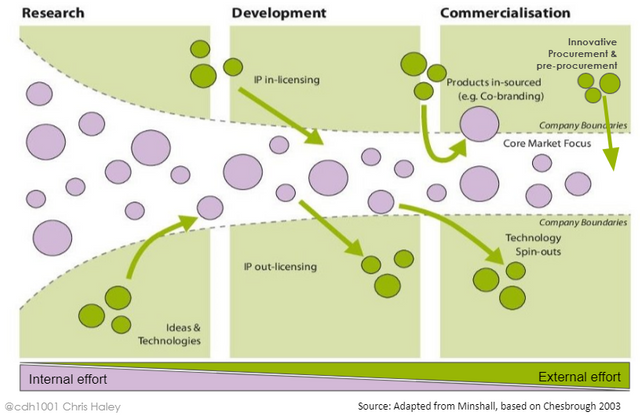Some thoughts on 'Open Innovation' and Collaboration.
The term is commonly used today, but often in ways which don't suggest a deeper understanding of the issues. It was coined by Berkeley academic Henry Chesborough to describe a change in the traditional innovation processes of organisations, although the phenomenon he described is clearly much older.
In essence, open innovation sees a flow of new ideas into and out of the organisation, at different stages of development. If traditional innovation is thought of as a pipeline, then open innovation is instead a ‘permeable funnel’:
Increasingly, this is becoming the dominant mode of innovation for organisations, in both the public and private sectors. There is a realisation that "not all the smart people work for us", as the saying goes, and that it is better to be the organisation which collaborates externally, rather than let those ideas be snapped up by someone else.
Does this not mean opening up about the things that you are working on, or your strategic pain-points? Yes. But many (perhaps most) firms have decided that the strategic advantage of maximising the consideration of possible approaches outweighs the strategic disadvantage of disclosing their direction & internal problems.
What does this mean for an organisation?
First, open innovation is more than just the flow of initial ideas: it encompasses a spectrum of development, from initial ideas to collaboration with fully-formed startups. An example of one end of the spectrum might be the 'Lego Ideas' platform, through which users can propose new concepts for the organisation to develop. At the other end of the spectrum might be Facebook acquiring Whatsapp.
There are various different types of interaction: following from the above, organisations which want a full open innovation pipeline need to consider a range of different mechanisms to engage with ideas at different stages of development
Strategy determines your choice of model / mechanism: not every organisation will want to engage with open innovation at every stage, but the choice of which stage to operate should be a strategic one, from which the choice of mechanism then follows. Organisations which jump straight in to opening an accelerator, say, may fall flat.
Culture determines your organisational receptiveness: notwithstanding the above, "culture eats strategy for breakfast". It is all very well having an open innovation strategy, but if the organisational culture rejects 'not-invented-here' ideas, then the strategy will be unlikely to succeed. So organisations need to work on building an open innovation culture first, and ensuring that this is maintained by incentives.
Open Innovation is more likely to be collaborative than transactional: some open innovation falls into the first camp - for example, there is a lot of cross-licensing of IP in some industries. But most open innovation is fundamentally collaborative: the ideas and part-formed technologies are usually not market-ready, and so it is not simply a case of buying them, but of collaborating to co-create or co-develop the innovation.
This last point is important, so I'll expand on it a bit. This is where many organisations that are new to open innovation go wrong: they assume that the relationship is purely transactional. This turns off collaborators, and often means that they don't understand the need for internal change. True collaboration often entails a little bit of compromise and flexibility - like changing some of your own internal processes to accommodate your collaborator's needs and expectations.
(As an aside, I see signs that this may conceivably change, with DAOs blurring the line between transaction and co-operation. Until now, it has been difficult for organisations to conceive of transactional frameworks for part-formed ideas, but some DAOs are building systems to reward contributors for precisely this. And Steemit is, in part, another way of doing that!)
Open Innovation cannot therefore simply be a way of outsourcing or 'buying-in' innovation whilst remaining unchanged: successful open innovation requires rethinking internal strategy, processes, culture. More collaboration also means developing new skills - both on a personal level and an organisational level. Collaborating isn't always easy - for instance, a startup collaborating with a large corporate will encounter many differences in size, culture, processes, goals, etc. For organisations which can work out how to do this, however, the rewards are large. Put another way, the ability to collaborate with other organisations in spite of differences will increasingly be a source of competitive advantage.
This is one of the reasons why the crypto space is so exciting: people are creating new frameworks to enable collaboration which (i) crosses distance, (ii) minimises the trust required, (iii) reduces friction, and (iv) rewards successful efforts!
